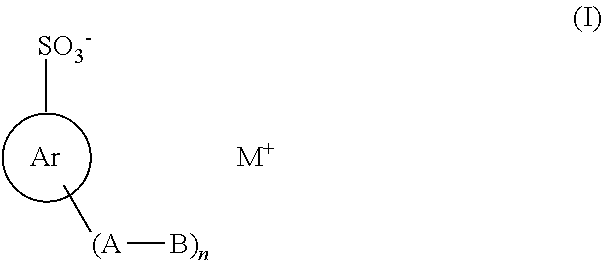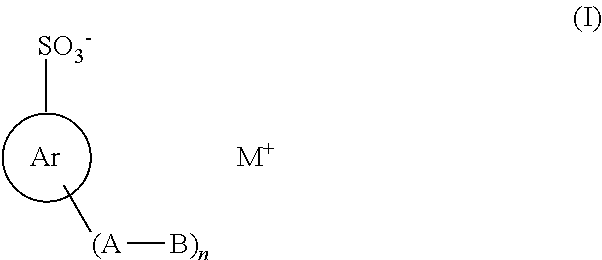Actinic ray-sensitive or radiation-sensitive resin composition and method of forming pattern with the composition
a technology of radiation-sensitive resin and resin composition, which is applied in the direction of photosensitive materials, instruments, photomechanical equipment, etc., can solve the problems of unsatisfactory above-mentioned chemical amplification system, unsatisfactory acid generator in many respects, and dirty exposure apparatus
- Summary
- Abstract
- Description
- Claims
- Application Information
AI Technical Summary
Benefits of technology
Problems solved by technology
Method used
Image
Examples
example
[0620]The present invention will be described in greater detail below with reference to its examples. However, the subject matter of the present invention is in no way limited to these examples.
[0621]
[0622](1) Synthesis of compound A1-1
[0623]
[0624]Aluminum chloride amounting to 6.83 g was added to 20.0 g of benzene and agitated while cooling at 3° C. Then, 40.4 g of cyclohexyl chloride was slowly dropped thereinto. After the completion of the dropping, the mixture was agitated at room temperature for 5 hours and poured into ice water. An organic layer was extracted by use of ethyl acetate, and the obtained organic layer was distilled at 40° C. under reduced pressure and further at 170° C. under reduced pressure. The resultant matter was cooled to room temperature, and 50 ml of acetone was poured thereinto to thereby carry out recrystallization. The crystal obtained by the recrystallization was collected by filtration. Thus, 14 g of tricyclohexylbenzene was obtained.
[0625]
[0626]Tricy...
example b
[0718]A resist solution was prepared according to exactly the same procedure as in Example A except that 0.06 g of the polymer shown below was added to the photosensitive composition of the Example 1A. The resist solution was applied in the same manner, thereby obtaining a resist film. The obtained resist film was patternwise exposed through a liquid for liquid immersion (pure water) by use of an ArF excimer laser liquid immersion scanner (manufactured by ASML, XT1250i, NA0.85), thereby attaining the same pattern formation as in Example A. It was ascertained that in all of the sensitivity, resolving power (y), line edge roughness and pattern profile, the same evaluation results were obtained on the obtained patterns.
[0719]
example c
Examples 1C to 16C and Comparative Examples 1C and 2C
[0720]
[0721]Referring to Table 2 below, with respect to each of the resists, the individual components were dissolved in the solvent and passed through a polytetrafluoroethylene filter of 0.1 μm pore size, thereby obtaining a positive resist solution of 14 mass % solid content.
[0722]
[0723]Each of the obtained positive resist solutions was uniformly applied onto a silicon substrate having undergone a hexamethyldisilazane treatment by use of a spin coater, and heated and dried on a hot plate at 120° C. for 90 seconds, thereby obtaining a 0.4 μm resist film.
[0724]The obtained resist film was patternwise exposed through a line-and-space mask by use of a KrF excimer laser stepper (NA=0.63). Immediately after the exposure, the resist film was heated on a hot plate at 110° C. for 90 seconds. Thereafter, the resist film was developed with a 2.38 mass % aqueous tetramethylammonium hydroxide solution at 23° C. for 60 seconds, rinsed with pu...
PUM
| Property | Measurement | Unit |
|---|---|---|
| wavelength | aaaaa | aaaaa |
| roughness | aaaaa | aaaaa |
| mol % | aaaaa | aaaaa |
Abstract
Description
Claims
Application Information
 Login to View More
Login to View More - R&D
- Intellectual Property
- Life Sciences
- Materials
- Tech Scout
- Unparalleled Data Quality
- Higher Quality Content
- 60% Fewer Hallucinations
Browse by: Latest US Patents, China's latest patents, Technical Efficacy Thesaurus, Application Domain, Technology Topic, Popular Technical Reports.
© 2025 PatSnap. All rights reserved.Legal|Privacy policy|Modern Slavery Act Transparency Statement|Sitemap|About US| Contact US: help@patsnap.com



